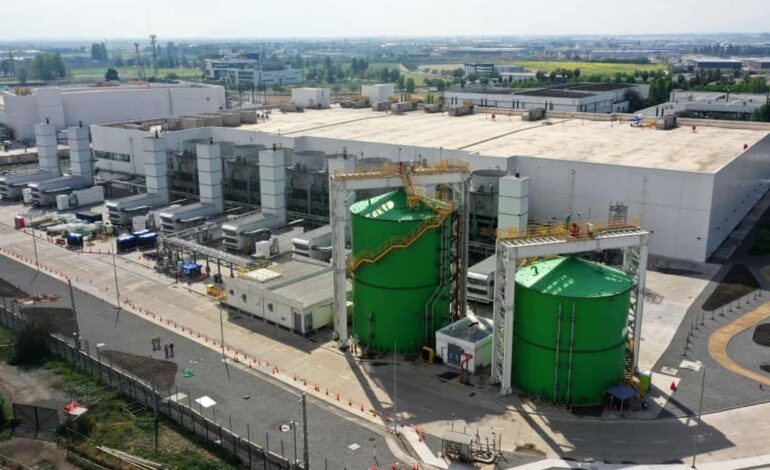Advocates Warn of PFAS Pollution Linked to Data Centers’ Growth

Public health advocates are sounding the alarm over potential pollution from data centers, particularly concerning the use of PFAS, commonly known as “forever chemicals.” As the demand for data centers surges due to the rapid expansion of artificial intelligence, concerns about their environmental impact, especially regarding emissions and water consumption, are growing.
Data centers, essential for managing the digital infrastructure of major tech companies like Google, Microsoft, and Amazon, require significant electricity and water resources. Critics argue that these facilities are hindering the United States’ shift towards clean energy, as they often rely on fossil fuel plants to meet their energy demands. Recently, advocates have focused on the use of PFAS, which includes a class of over 16,000 chemicals linked to severe health risks, such as cancer and kidney disease. These chemicals do not break down naturally in the environment, earning them their notorious nickname.
Advocates are particularly concerned about the facilities’ reliance on PFAS gas, or f-gas, which can be a potent greenhouse gas. The Environmental Protection Agency (EPA) announced in mid-September 2023 that it would expedite the review of new PFAS and other chemicals used by data centers. This decision has intensified discussions about the environmental implications of these facilities. Jonathan Kalmuss-Katz, an attorney with Earthjustice, emphasized the lack of adequate research on this issue, stating, “This issue has been dangerously understudied as we have been building out data centers, and there’s not adequate information on what the long-term impacts will be.”
PFAS chemicals are commonly used for their water-, stain-, and grease-resistant properties. Their presence in data centers raises two main environmental concerns: direct pollution from the chemicals used in operations, such as cooling equipment, and indirect pollution from their disposal. When equipment containing PFAS is discarded, the chemicals often end up in landfills, where they can leach into local waters, or are incinerated. However, incineration does not completely eliminate PFAS; it merely breaks them down into smaller, still-harmful compounds.
The Broader Environmental Impact
Environmental advocates argue that the data centers contribute to PFAS pollution both directly and indirectly. The chemicals used in cooling systems lead to on-site pollution, while the production of semiconductors necessary for data centers increases emissions from manufacturing plants. The focus on AI development has overshadowed the potential environmental consequences of expanding data centers, with little political will to address these issues.
Lenny Siegel, a member of Chips Communities United, voiced concerns about the competitive race between the United States and China in the tech sector. He remarked, “If we had a sensible approach to these things, then someone would have to present some answers before they develop and use these systems.”
Cooling systems in data centers typically involve two methods: water cooling and f-gas refrigeration. Water cooling systems consume vast amounts of water and may involve the discharge of various chemicals into the environment. The newer “two-phase” systems utilize f-gas as a refrigerant, which theoretically minimizes intentional release. However, leaks can occur, and disposal of f-gas at the end of its life presents further challenges.
Recent studies indicate that TFA, a compound formed from f-gas, is more toxic than previously understood, potentially affecting reproductive health. As levels of TFA continue to rise in various environments, the long-term implications remain uncertain. Some f-gases, recognized for their greenhouse gas potency, can linger in the atmosphere for thousands of years.
As the demand for data centers grows, so does the concern regarding the production and use of PFAS. Chemours, a major f-gas manufacturer, has announced plans to increase production at its facilities in West Virginia and North Carolina to meet the rising demand in the AI sector. Residents in these regions have reported health issues linked to Chemours’ pollution, raising alarms about the company’s expansion.
In response to these concerns, environmental groups in Minnesota are collaborating with state lawmakers to draft legislation requiring companies to disclose their use of PFAS and other chemicals in cooling systems. Avonna Starck, Minnesota state director for Clean Water Action, expressed frustration with the lack of transparency from tech companies regarding their chemical usage. “There’s so much you just don’t know, and we’re at the whim of these big corporations and what they’re willing to tell us,” she said, emphasizing the community’s right to know about potential hazards.
The ongoing debate about PFAS pollution from data centers highlights the necessity for rigorous environmental safeguards as the technology sector continues to evolve. While the industry asserts that its practices are safe, advocates are pushing for greater accountability and transparency to protect public health and the environment.






